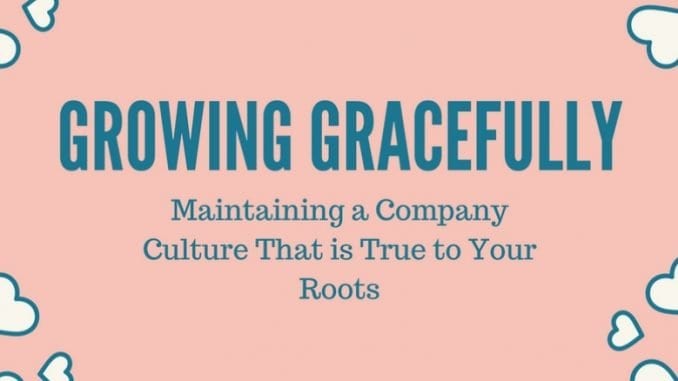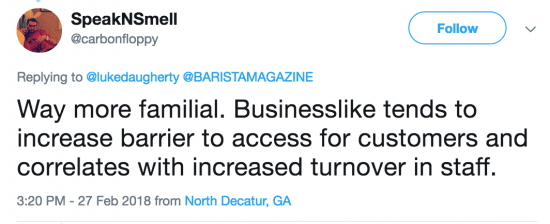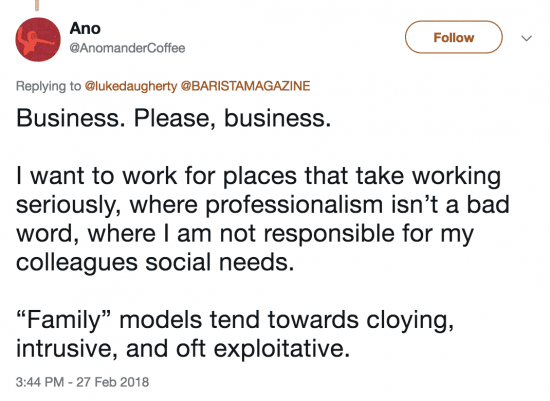
We hear terms like “mom and pop shops” or “family-like business” all the time, but is this actually a good thing? In this series, we’ll explore what it means to grow gracefully, as well as the differences between a family vibe and a professional setting in the café.
BY LUKE DAUGHERTY
SPECIAL TO BARISTA MAGAZINE
Volume 3
In the world of speciality coffee, it seems that consumers and coffee professionals alike are often faced with two opposing choices. Do you favor the neighborhood shop, with its single location, quirky staff, and eclectic aesthetic? Or do you favor the other one, with its multiple stores, slick branding, and fine-tuned marketing? For employees the question goes deeper, from the externals to the company culture itself. Do you want to work in an environment that feels familial, or one that’s more businesslike?
Even this thread of Twitter dialog illustrates that there are strong feelings on both sides of the issue. To name a few:


But aside from stirring up social media debates over company culture, we wanted to offer some practical steps toward health in this area. So we’ve been digging in with some seasoned coffee pros and business owners recently to find a way to walk this tenuous tightrope of company culture. We’ve pulled together six keys to success, and after looking at the first two a few weeks ago and the second set last week, we’re wrapping up with our final two keys today.
Key #5: Strive for alignment, but leave room for variety.
“Helping people understand the culture of your space and where your business is trying to go is imperative,” says Ian Williams, who left a corporate job at Nike three years ago to found Deadstock Coffee in Portland, Ore. This goes beyond merely communicating the idea to seeking alignment with your vision. Only with alignment can you have confidence that your employees are all working toward similar goals. This is true whether you have a particularly fine-tuned brand like Deadstock—which is built around sneaker culture—or not.
At times this may mean that you have to part ways with employees, not for performance reasons, but because they don’t align with the culture you’re trying to create. This might be especially hard if you’ve already created a fairly familial, relaxed culture. “Trying to make a laid-back environment can bite you in the butt,” says Ian. “Sometimes people don’t even seem like they want to be there, and I don’t know why they took the job.”
That being said, be sure your vision isn’t too narrow or unnecessarily exclusive. Every employee wants something different out of their workplace relationships, and there should be room for a realistic amount of variety within your company. Further, the process of alignment is one in which you have the opportunity to create a shared sense of ownership over the culture with your employees.
“It’s going to be much easier to grow if I bring in people that know the business alongside me,” says Andrew Cash, founder and sole owner of Jubala Coffee in Raleigh, N.C. “I’ve got a great team that knows our customers well. They probably know more than I do at this point.” This idea of sharing the company’s vision and culture, for Andrew, doesn’t mean that anything goes. He strives to find good fits through the interview process—folks who will fit into the essentials of his culture while still contributing their own personalities to the mix and aiding in the overall growth of the organization.
An important caveat should be made here, in light of some recent reported events of abuse. It’s equally critical, if not more so, for employees to consider their willingness to align with the culture. This is especially true when it comes to situations of abuse. As one who has experienced the pressures of an obviously toxic, unhealthy familial culture, 2017 Coffee Masters champion Erika Vonie is careful to emphasize this. “I was told I should be grateful that I have a job in the first place,” she says, recounting when she finally pushed back against the culture. Those moments should be ones in which you don’t hesitate to make your exit. “As soon as it becomes clear that it’s happening, remove yourself from the situation,” she says, “because it will only continue to get worse.”
Key #6: Stay attuned to the changing climate and seasons, and the gaps in your company.
Like coffee quality, culture is a moving target. Just as climate changes influence the decisions of coffee producers or the age of greens influence roasters’ profiles, so should changes in your business influence your vision for the culture. You may set out with one thing in mind, but a variety of factors, including ones we have touched on in this series, will influence the exact shape and feel of your team at any given time. As a leader, you should be in tune with what season your company is in, and how the climate is changing.
“We have gone from five people on our team to 40 people, and our business is very different today than it was when we started,” says Andrew of Jubala Coffee. “There are different tensions that didn’t exist when we first started, and we have to be able to adapt and adjust as we grow.” It’s important as the company grows to take the time to evaluate what’s still working and what isn’t, and find ways to hold on to what’s made you successful as you adapt and change. It may not be possible to maintain the same level of intimacy on a team of 40, but there may also be more opportunities for others to share ownership in the business as a whole, as Andrew has been experiencing.
There are broader concerns to be considered as well, argues Kristina Jackson, an Intelligentsia Coffee shift leader whose own work pushing for more diversity and inclusivity in the Boston area has brought those other concerns to the forefront. “The challenge is,” she says, “the larger a company gets, the further that marginalized people get pushed into the margins and get lower on the priority list. Ironically, I see some shops trying to create a family atmosphere, but they have no one on the team that is a mother—no one who is in their 40s or 50s.”
“It doesn’t matter if the company is big,” she adds. “Diversity is important either way.”
Bringing it all back home
Intentionally creating your company culture, and growing it gracefully, requires as much work as managing your margins. And in today’s world, you can’t afford to ignore it. As you look at your own business, if may be helpful to remember that there need not be as wide a gap as we often think between the styles of business we have been exploring in this series.
“When I think of ‘family,’ I think of a culture that truly supports each other,” says Kristina of Intelligentsia. “They don’t just accept differences, they embrace and celebrate them. And company leaders work to make everyone as comfortable as possible. The other part of that is considering your customers—I think encouraging your team to establish a certain rapport with customers to learn their needs. An owner or manager can’t always be there, so they have to build trust with the rest of the team to build the business. You can’t do that if you treat your team like a number.”
Many would argue that’s just good business.
 ABOUT THE AUTHOR
ABOUT THE AUTHOR
Luke Daugherty has been in the coffee industry for more than 13 years, working as a barista, roaster, and café manager along the way, all the while growing more intrigued with this lovely beverage we all can’t get enough of. He’s an SCA-certified green coffee buyer, and he lives with his wife and three children in Louisville, Ky.

